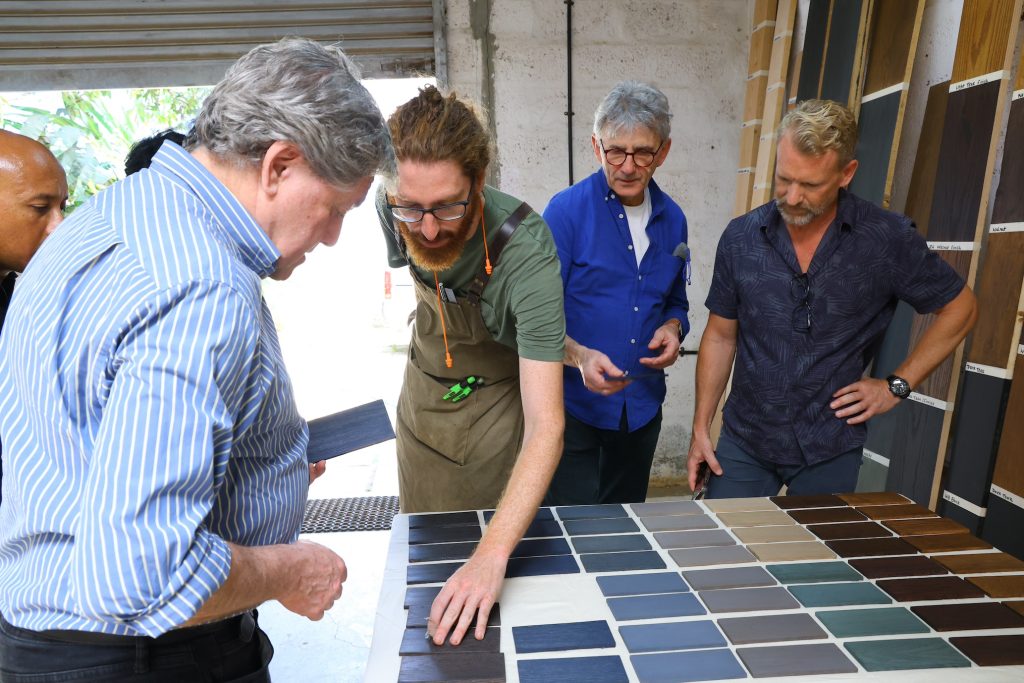REFRACTIONS, a cross-cultural, international design collaboration between Adam Markowitz and Phantom Hands, is set to be unveiled later this year as part of BLR Hubba, a two-week, all-encompassing annual cultural festival organized in December where the city comes together to experience Bangalore in all its fullness and richness. Commissioned by the American Hardwood Export Council (AHEC), the leading international trade association for the American hardwood industry, the collection made from American red oak, cherry and maple includes a dining table, a bench, two pendant lights and a wall sconce.
“Having followed Phantom Hands for a few years, I was initially a little apprehensive about the opportunity of collaborating. Partially because of the intimidating array of designers already working with them, but also because of apprehensions about the nature of the collaboration. I was very conscious of being an outsider in India, being unfamiliar with the culture, and wanting to make sure that the project was a genuine collaborative process. I wanted the work to look like it could not have happened anywhere else,” said Adam Markowitz, Founder, Adam Markowitz Design.
Prior to the first meeting with Phantom Hands, Adam did some reading and research into the experience of Corbusier and the Eames in India, the foundation of the National Institute of Design (NID) and some critiques of foreign designers falling into the trap of ‘orientalism’ and fetishising the ‘otherness’ of India. According to Markowitz, he was initially unsure how to best engage in a way that was respectful and celebrated the meeting of two craft & design approaches, but at the same time did not feel forced and insincere. His intention was to not start sketching until he had arrived and had spent some time with Phantom Hands in Bangalore.
“I did arrive in India with some initial ideas; however, these were quickly set aside. I was reassured and steered out of this existential trouble with the encouragement that whatever we did would inherently achieve this goal, and that trying to shoehorn it in from the start would be counterproductive. Both Deepak Srinath and Aparna Rao, Co-founders of Phantom Hands, identified the key things that they appreciated about my work – the blend of being an architect, furniture designer and woodworking craftsman. This mutual understanding and appreciation set the foundation for our collaboration from the outset,” added Markowitz.
The initial brief involved Adam being given a specific architectural space to consider as a starting point, with the aim of leveraging his specific set of skills. Phantom Hands were also aware of the work that Adam had done with bending and curvature in wood, and they were interested in learning more about those techniques specifically, so ideally the work would involve bending and curvature to encourage the opportunity for skill sharing. Lastly, Aparna asked Adam to consider the Wood Rose, a unique flower that had personal significance to her as a possible starting point. These formed the defining starting elements of the project and shaped the initial design process.
“Key to the design approach was the idea of curvature. From the outset, I elected to use bent laminating as the primary bending technique. There are some unique characteristics of bending wood, requiring an understanding of the ways that it likes to bend (e.g. – around one axis, and generally with the grain of the wood). To laminate wood, you slice the timber into thin veneers. These thin veneers are individually flexible, which allows you to bend them into the shape and then glue them back together. The curves of the resultant shapes can be incredibly strong. This is the inherent strength of curvature, and what my designs were looking to explore,” stated Markowitz.
“The Indian way of woodworking is very interesting as it seems to me to sit halfway between western and eastern woodworking techniques (e.g. Japanese and Chinese methods). The work is done on the floor in an eastern style. The planes they use are a combination of steel and wood (Japanese & Chinese planes are primarily only wood), and are used in a push motion, a sort of a hybrid between a western style and an eastern style. The saws work in a pull manner in an eastern style. What was impressive to me was the accuracy of the curvature and joinery, which is still executed entirely by hand, without CNC or even advanced jigs. So much is still down to the skill of the particular craftsperson,” added Markowitz.
“It was through AHEC that we could confront some of our misconceptions and biases around the use of non-indigenous species of hardwood. The expertise and knowledge about timber standards and woodworking processes that came along with the collaboration have been deeply educational. Through the development of the collection, we were able to quickly delve into the uncharted subject of wood bending and building forms and structures with them. Armed with Adam’s proactive, rigorous, and patient insights we have been able to expand the range of our hand-crafted techniques and design language,” said Aparna Rao, Co-Founder, Phantom Hands.





